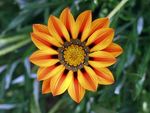EXTENSION MASTER GARDENERS
←
→
Page content transcription
If your browser does not render page correctly, please read the page content below
EXTENSION MASTER GARDENERS
A Program of the University of Tennessee Extension Sequatchie and Bledsoe Counties
Gardening News and Notes
June 2021
2021 SVMG Calendar
• Quarterly Meeting and Tomato Tasting, July 24, 2021 - Pikeville, Bledsoe County Extension office
• August 2021 County Fairs
• Quarterly Meeting November 6, 2021, 9:00 AM Central, Dunlap location to be announced
2021 Area Events and Programs
• Turf Tuesdays – Monthly, first Tuesday April-October, online at http://tiny.utk.edu/TurfTuesday
• June 15, 8 a.m. CDT, Fruits of the Backyard – Middle Tennessee AgResearch and Education Center at Spring Hill
• June 24, 2021, Central Region MG Meeting in Warren County
• July 8, 8 a.m. CDT, Summer Celebration – West Tennessee AgResearch and Education Center at Jackson
• August 26, Turf & Ornamental – TBA, East Tennessee AgResearch and Education Center Plant Sciences Unit at Knoxville
• August 31, 8 a.m. CDT, Fall Gardener’s Festival - Plateau AgResearch and Education Center at Crossville
• September 2, 8 a.m. CDT, Steak and Potatoes – Plateau AgResearch and Education Center at Crossville
• UT Arboretum Butterfly Festival – September 18, 10 a.m. EDT, Forest Resources AgResearch and Education Center – UT
Arboretum Auditorium at Oak Ridge
Friday Focus Series
• July 23- Cut flowers and MGs in TN
• Sept. 24- MGs and Arboretums in Lebanon and Ohio
Friday Focus Series Signup Form: https://forms.gle/bg6HaoSDSGHE5Dc4A
Playlist at https://www.youtube.com/watch?v=1XEhPXe1-zw&list=PL1yNe3Yb9E37WrVhvEZnI07ID_ntc_G2s
UT Publications and videos
• The latest session of Back Porch Forestry, by Dr. Dave Mercker, has been posted. This segment addresses common
insects that create problems for trees in our region. In July Dr. Mercker will examine common tree diseases. All
sessions are located on YouTube at this site: https://tiny.utk.edu/BPF
• W 1007 Laurel Wilt - Authored by Walker Fowler, Alan Windham, and Denita Hadziabdic, Department of
Entomology and Plant Pathology.
• Emergency Broadband Benefit The Emergency Broadband Benefit Program is a program to help families and
households struggling to afford broadband internet service during the COVID-19 pandemic. Our own Kim Davis is
listed as a co-author for this fact sheet.Sequatchie Valley Master Gardeners June 2021
UT Gardens
Plant of the Month
The Eye-catching Trumpet Honeysuckle
Submitted by Shalena Durkot, coordinator, UT Gardens, Crossville
Lonicera sempervirens, commonly called trumpet or coral
honeysuckle, is a climbing vine native to the eastern half of the
United States. It is a real eye-catcher in the garden and is widely
known to attract butterflies and hummingbirds. Trumpet
honeysuckle cultivars can be found that will provide blooms
throughout the growing season followed by small, red berries that
are eaten by songbirds.
The genus, Lonicera, is named for German botanist, Adam
Lonitzer (Lonicer). The species, “sempervirens” means evergreen;
however, this only holds true in milder climates of the Deep South.
This species should not be confused with the terribly invasive
Lonicera japonica. Although somewhat vigorous, trumpet
honeysuckle does not grow or spread as rampantly as our native
crossvine or trumpet creeper.
Trumpet honeysuckle is a native climbing vine with Trumpet honeysuckle is easy to grow and thrives in zones 4 to
colorful blooms that attract butterflies and 9. It prefers full sun but can tolerate some shade. Best bloom
hummingbirds. Photo of specimen at the UT Gardens,
production occurs with six hours of direct light. While it appreciates
Crossville, by S. Durkot, courtesy UTIA.
organically rich soils with good drainage, the vine will thrive with
average, medium moisture, and neutral to acidic soils. Trumpet honeysuckle is also tolerant of clay, black walnut, and deer.
The vine has no serious pest or disease problems, but powdery mildew and leaf spots may occur, particularly where
summers are hot and humid and have been known to occur particularly where it gets less than ideal sunlight and air
circulation. Aphids can occur on occasion. Pruning can be done
throughout the growing season after its flush of blooms if needed.
Trumpet honeysuckle is easily propagated by softwood cuttings
taken in late spring or summer.
The colorful twining vine grows to 20 feet, and it is suitable for
fences, trellises, and arbors. It looks lovely cascading from retaining
walls or left to sprawl as a groundcover on slopes and
embankments. Trumpet honeysuckle’s tubular flowers are perfect
for hummingbirds and other long-tongued insect pollinators. The
plant is a larval host to spring azure butterflies and snowberry
clearwing moths. The fall fruit is enjoyed by quail, purple finches,
goldfinches, hermit thrushes, eastern bluebirds, and American
robins.
Some of the popular cultivars of trumpet honeysuckle are:
• ‘Cedar Lane’- strappy bluish foliage, scarlet flowers with
better resistance to aphids
• ‘John Clayton’- yellow flowers
The profusion of blooms produced by Lonicera
• ‘Sulphurea’- yellow flowers
sempervirens ‘Major Wheeler’ will cascade over any
Recommended reblooming forms: structure, including fencing. Photo by C. Reese, courtesy
• ‘Major Wheeler’- prolific scarlet flowers UTIA.
• ‘Alabama Crimson’- deep red flowers
• ‘Blanche Sandman’- orange-red flowers
Specimens of ‘Blanche Sandman’ have performed well in the UT Gardens’ site in Crossville, also known as the Discovery
Gardens. ‘Major Wheeler’ is recommended by the staff at the UT Gardens, Knoxville, and UT Gardens, Jackson.
2Sequatchie Valley Master Gardeners June 2021
Gardening Tips
“Gardening requires lots of water - most of it in the form of perspiration.”
Lou Erickson
July Gardening
Here is your “to do” list for the garden for July. These tasks were submitted by Jason Reeves, horticulturist, and curator
at the University of Tennessee Gardens in Jackson.
• Many plants are easily propagated by layering. Hydrangeas, viburnums, weigela, trumpet honeysuckle, Carolina
jessamine, and climbing roses are a few that will root if the stems are fastened down and covered with soil.
• Start planning your fall vegetable garden. Late July is the time to start seeding your winter broccoli, cabbage,
cauliflower, and brussels sprouts to be transplanted into the garden in mid-August.
• You should be receiving fall nursery catalogs in the mail soon. Now would be the time to begin planning a new garden.
• Raise the height of your mower to reduce stress on your lawn and to conserve moisture in the ground. For best results,
mow 2 inches for Bermuda grass, 1 to 2 inches for Zoysia, and 2.5 to 3 inches for fescue.
• July is a good month to prune “bleeder” trees like maples, dogwood, elm and birch, and other trees that “bleed” when
pruned in winter.
• Give your chrysanthemums and aster the last pinching no later than mid-July.
• Keep your perennials deadheaded so they will continue to flower. Be sure to remove the fading flower down to a leaf
node or new bud.
• Cut back early planted annuals that are getting leggy or out of control by one-third to keep them looking good into the
fall. Give them a shot of a water-soluble fertilizer. Good candidates include impatiens, salvia, sweet potato vine, trailing
or ground-cover-type petunias, and herbs, like basil.
• Avoid pruning spring-flowering shrubs from now until next spring. Anything you remove now will also be removing next
year's flowers. Spring-flowering shrubs include azaleas, camellias, witch hazels, and rhododendrons among others.
• Now is the time to prune overgrown oakleaf and mop-head hydrangeas.
• Cut flowers for a bouquet early in the morning. Immediately place them in water. Good cut flowers include purple or
white Echinacea (coneflower), Rudbeckia (Black-eyed Susan), zinnias, salvia, dahlias, sunflowers, Mexican sunflower,
celosia, jewels of opar, cosmos, dill, fennel, Gomphrena (globe amaranth), Gaillardia, Monarda (bee balm), phlox,
yarrow, ornamental grasses, and Artemisia.
• Cut old flower heads off Hydrangea arborescens such as 'Annabelle' to get a second, but smaller, flush of flowers.
• July is a good time to buy crapemyrtles. They are in flower now so you can be certain to get the flower colored desired.
Crapemyrtles should not be fertilized after mid-July to allow them time to properly harden off by fall.
• Keep birdbaths clean and filled with water through the hot weather, but be sure to control mosquitoes by eliminating
sources of stagnant water.
Master Gardener Hours
To date June 1, 2021
• Total Project Hours: 180.35 Total Hours Value: $3996.56
• Total Value: $4,203.56 (including hours and mileage)
• Total CEU Hours: 91
3Sequatchie Valley Master Gardeners June 2021
Box Tree Moth
The U.S. Department of Agriculture’s Animal and Plant Health
Inspection Service (APHIS) has confirmed the presence of box tree
moth, Cydalima perspectalis, in the United States and Tennessee is a
state that may have received infested boxwood plants.
The box tree moth feeds mostly on boxwoods and can
defoliate and potentially kill boxwood plants if left unchecked. Once
the leaves are gone, larvae consume the bark, leading to plant
death. Signs of infestation include silky webbing and possibly
caterpillars located deep inside of the plants.
Caterpillars, they can be upto 1.5 inches long Box tree moth caterpillars are green and yellow with white,
yellow, and black stripes and black spots. The adult box tree moth
has two color patterns. The most common has white wings with
dark brown borders, while the dark pattern has solid brown wings
with a white streak or spot on each forewing. Both have a distinctive
white dot or mark in the middle of each forewing.
Boxwoods appear in many landscapes in Tennessee due to their
year-round green foliage and adaptability to changing weather. TDA
recommends anyone who purchased boxwood plants within the last
few months, inspect their plants for signs of the pest. If you suspect
your boxwood plant has been infested, contact TDA’s Plant
Certification Section at 615-837-5137.
Adult moths can have a wingspan of 1.5 to 1.75 inches
To learn more https://extension.psu.edu/box-tree-moth?fbclid=IwAR2uzMGr2IC-
2rOs6ingEyC5iEl9SgiPgi5JGF0boRrkDvBZ2z8UCJJ7a88
Photos Matteo Maspero and Andrea Tantardini, Centro MiRT - Fondazione Minoprio [IT] from Tennessee Dept. of
Agriculture Facebook page.
The Extension Master Gardener Program is a program of the University of Tennessee Extension
Sheldon Barker J. C. Rains
County Director & Extension Agent County Director & Extension Agent
Sequatchie Co. Bledsoe Co.
170 Church St PO Box 289
Dunlap, TN 37327 Pikeville, TN 37367
423-949-2611 423-447-2451
UT Extension Sequatchie County web page UT-TSU Extension Bledsoe County Webpage
Sequatchie County Facebook Bledsoe County Facebook
4You can also read
























































